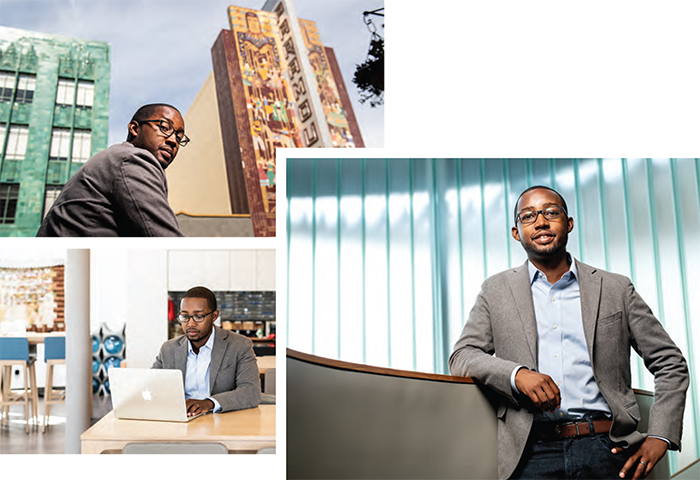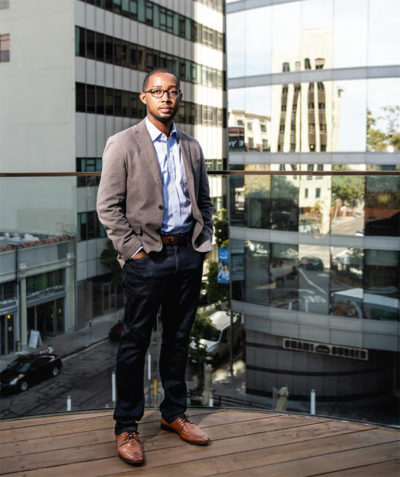
Brian Dixon, MBA’13, is a partner at Kapor Capital in Oakland, California.
Brian Dixon, MBA’13, has spent a lot of time with entrepreneurs. As a partner at Kapor Capital, a venture capital firm in Oakland, California, he works with companies in their early stages, those exhausting yet exhilarating days when entrepreneurs test out their ideas and dreams, seeing if they can take flight. “The companies are so small when they start,” says Dixon. “You really get a chance to know the founding team. That first year, you work with them directly.”
Kapor invests in companies seeking to address societal issues. Its diverse portfolio, which currently includes about 130 companies, encompasses such enterprises as Magoosh, a provider of affordable study prep for standardized tests; Velano Vascular, which aims to improve the way blood is drawn in hospitals; Honor, an online service that connects in-home caregivers with seniors and their families; Pigeonly, which offers an inexpensive way for people to communicate with incarcerated family members; and LendUp, a socially responsible lender that provides loans and credit cards to people with insufficient credit.
Working with these companies, Dixon has come to realize how personal they are for the entrepreneurs behind them. Pigeonly, for instance, was launched by someone who was once incarcerated, and one of the founders of Velano Vascular has Crohn’s disease and has spent much time in hospitals. If he asks the entrepreneurs why they started their companies, they will tell him from the heart about their experiences. “When you ask that question, there is something personal,” Dixon says. “That story of the lived experience is what separates someone who will go above and beyond to see an idea through.”
By backing entrepreneurs who are following their personal passions to make change, Dixon and his colleagues at Kapor are making a deep commitment to impact investing. A growing trend in the financial world, impact investing has two main goals. The first is a traditional one: to make a profit. But impact investing also is concerned with social and environmental returns on investment. Kapor, for example, focuses on tech companies trying to close gaps of access, opportunity, or outcome for low-income communities and communities of color. Health, education, and finance are among the sectors in which it invests.
When considering what venture to support, Kapor is certainly looking at a company’s financial health and potential, but the firm also is interested in a far bigger question: Can the company make the world a better place? “The impact companies that do it right think of all stakeholders,” Dixon says. “We hope as they grow, their impact will grow as well.”
More Socially Aware
Impact investing has grown out of a broader movement, that of investors becoming more attuned to the societal effects of their investments. Millennials and women, in particular, are increasingly thinking beyond bottom-line concerns, says Priya Parrish ’05, partner and chief investment office at Impact Engine, a Chicago investment firm committed to making positive social and environmental change. “It makes sense,” Parrish says. “People think about the implications of the items that they buy. Why not think about it regarding your investment portfolio?”
An early example of this socially aware thinking came during the era of apartheid in South Africa, when investors divested their money from companies doing business in the country. Investors also have chosen not to put their money in companies that don’t align with their values, avoiding, say, alcohol, gambling, or tobacco businesses.
A popular form of this socially conscious investing is known as Environmental, Social, and Governance, or ESG for short, and it focuses on what its name implies. Financial performance is still the main objective, but ESG investors will look at environmental (how much carbon is the company emitting?), social (how does the company treat its workforce?), and governance (how transparent is the company?) factors as part of a routine evaluation of a business. According to Morgan Stanley, nearly $23 trillion in investments, roughly one-quarter of all assets managed around the world, have some sort of ESG mandate.

Photos: Winni Wintermeyer
“It’s trending. People are voting with their money,” says Patrick Gregory, senior lecturer of finance at Babson and director of the Stephen D. Cutler Center for Investments and Finance. “It’s an area of interest to our students.”
The Babson College Fund, a group of about 25 students charged with managing a portion (just under $3 million) of the College’s endowment, considers ESG in its stock evaluations. “Our mandate is to outperform the S&P 500,” says Gregory, the fund’s director. “We have discretion on how we do that, and we do that by taking a 360-degree view of a company.”
Incorporating ESG has not hurt the fund’s returns, mirroring the experience of many other investors who were initially skeptical of ESG. “For many, that was a concern, that they would have to give up performance,” says Gregory. “But investor thinking has evolved.”
Impact investing, as practiced by alumni such as Dixon at Kapor and Parrish at Impact Engine, takes the socially aware investing of ESG one step further. Instead of simply taking ESG factors into account when doing a broad evaluation of stocks, impact investors have a much more active approach, directly supporting companies with a social mission. “Impact investing is the intention to create change,” says Parrish. “When you’re betting on a business, you’re betting on its impact.”
Compared with ESG, impact investing is not as widely practiced, though its numbers are still impressive and growing. In a survey of more than 200 leading impact-investing organizations, the Global Impact Investing Network, a nonprofit dedicated to championing and increasing this type of investing, found that respondents cumulatively managed $228 billion in assets. “When you look at the broad trends in investing, it’s one of the top 10,” Parrish says. “Impact investing is right up there.”

Photo: Winni Wintermeyer
At Kapor Capital, Brian Dixon and his colleagues focus on tech companies trying to close gaps of access, opportunity, or outcome for low-income communities and communities of color.
At the heart of impact investing lies the belief that business has the potential to address and solve intractable problems. “Philanthropy and government and traditional forms of investing are not sufficient to address the dilemmas the world faces today,” says Cheryl Kiser, executive director of Babson’s Lewis Institute for Social Innovation. “Philanthropy can only take you so far. Impact investing is a whole new frontier. It is using the mechanisms of finance in different ways to advance social progress. It’s a new way of financing the future.”
Parrish agrees. “The idea of business having a seat at the table for solving problems isn’t going away,” she says. Furthermore, impact investing is a way to empower typical investors, enabling them to make an immediate difference in issues that concern them. “The old way of making enough money to then give it away doesn’t work,” Parrish says. “Look at the state of our society. There are enough pressing problems. Impact investing is a way for everyone to feel like they’re doing something now. That resonates.”

Photo: Bob Stefko
Priya Parrish ’05 is partner and chief investment office at Impact Engine in Chicago.
The World Has Shifted
Parrish didn’t intend to become an impact investor. As a Babson student, she lived in E-Tower, started a few businesses, and planned to become an entrepreneur. But then she enrolled in a social entrepreneurship class with professor Natalie Taylor, and she took an independent study with professor James Hoopes, looking at corporations’ role in addressing societal issues. “My social conscience was developing. I wanted to do something for the world, but I didn’t want to be a social worker,” she says. “I saw that for-profit companies were a powerful tool to solve social issues.”
Before she even graduated from Babson, Parrish took a job at a small research firm, working on growing its ESG index. Such socially aware investing wasn’t as common then. “Most of my friends thought I was nuts,” Parrish says. “I was doing well at Babson. I had job opportunities. My friends were asking, ‘What are you doing?’ ” Other jobs in investing followed through the years, some with a socially conscious bent, others not. Parrish has witnessed how ESG and impact investing have become more accepted and widespread. “No one is saying anymore, ‘What are you doing?’ ” she says. “The world has shifted. Everyone knows what I’m talking about.”

Photo: Bob Stefko
The world of impact investing has become almost synonymous with new ventures, so at Impact Engine, Priya Parrish is putting together a private equity fund focusing on more established businesses. “I want to support mission-driven companies that are scaling,” she says.
Today, Parrish is the impact investor in residence at the University of Chicago’s Booth School of Business, where she earned her MBA in 2009, and she has worked at Impact Engine since April. While the firm generally invests in early-stage tech companies that target issues such as resource efficiency, education, health, and economic empowerment, Parrish is busy putting together a private equity fund that focuses on more established businesses.
The world of impact investing, she says, has become almost synonymous with new ventures. Older companies can be overlooked. “I don’t want to put 100 percent of my money in venture capital,” she says. “I want to support mission-driven companies that are scaling.”
More established companies certainly face challenges, says Kapor Capital’s Brian Dixon. As they age, they may drift from the social missions that so defined them in their early days, alienating customers and employees who were drawn to them because of that mission. For instance, a company that donates one item for every one it sells, a common business model used by companies selling eyeglasses, books, and a host of other products, may one day be tempted to stop donating that second item and pocket the extra profits instead. “As the company gets bigger, how do they keep that core mission?” Dixon asks.
Like Parrish, Dixon once pursued entrepreneurial ventures. As a teenager, he founded a custom sneaker company. His proudest moment was seeing a picture of basketball superstar LeBron James holding one of his shoes. “I was blown away,” Dixon says. “I’ve been showing that picture to people for a decade now. It still gets me fired up.”
Later, he was co-founder and CEO of a social networking aggregator that drew attention from investors. That was the first time he saw up close the work that venture capitalists do. “I thought, ‘This is something I want to do,’” Dixon recalls. While he majored in computer science in college and worked as an IT analyst, Dixon eventually decided to earn his MBA and focus on venture capital. He did a couple of internships at Kapor before joining as an associate after graduating from Babson. He was named a partner in 2015.
A big part of Kapor’s mission is to make sure that entrepreneurs from all backgrounds are heard. If entrepreneurs want to reach out to Kapor, they don’t need to network to find the right people to contact. All they have to do is fill out a form on the firm’s website. Every Monday, the firm’s staff pore over the submissions. “Not all entrepreneurs end up at great schools or have a great network. They should still have a chance to grow a business,” Dixon says. “A lot of pitches come over the website. We look at each one.”
Kapor employs a diverse team in an industry, venture capital, not known for its diversity. By having staff from all walks of life, the Kapor team hopes, in turn, to identify more readily with all kinds of entrepreneurs, regardless of their background. The team may even have firsthand experience dealing with the social issues the entrepreneurs are trying to address. Dixon, for instance, remembers his parents sacrificing to scrape enough money together to send him to SAT prep classes, so he identifies with the mission of the company Magoosh, the provider of affordable study prep for standardized tests. “You get attracted to companies that speak to your soul,” Dixon says.
Since 2016, all companies that Kapor invests in are also required to sign the Founder’s Commitment, which calls on ventures to establish diversity and inclusion goals, invest in tools and training that mitigate bias in hiring and promotion, and organize volunteer opportunities in the underserved communities that reflect a company’s customer base. “The whole mission is to diversify tech. The tech industry does not look like America,” Dixon says. “Why not build in diversity and inclusion from the start?”
Urgent and Necessary
Impact investing may be a growing movement, but it’s still relatively new. The Lewis Institute’s Cheryl Kiser often encounters students who want to solve a social problem, but they tend to focus on traditional solutions such as starting a nonprofit. She’ll point out the potential of impact investing to them. “How do you figure out our unique contribution to solving that problem?” Kiser will ask them. “It could be in the realm of finance.”
Impact investing also has to contend with perceptions of subpar returns. Many assume that making a social impact means sacrificing profit. That assumption, however, isn’t necessary true. “The numbers will prove out otherwise,” Dixon says. “We have early signs that you can do both.” If anything, the challenge for impact investors is measuring their social and environmental returns on investment. Dollars and cents are easy to track, but progress on a societal problem can be slow and hard to quantify. Patience is required. As Kiser says, “You can’t solve a social problem in a quarter.”
But addressing problems, even daunting ones that are global in scale, is something that impact investing can do very well, believes John Kluge, MBA’17. The Babson trustee is the founder and managing director of the Refugee Investment Network, an impact investing and blended finance collaborative based in Washington. According to the United Nations High Commissioner for Refugees, 68.5 million people were displaced from their homes in 2017, and Kluge’s organization is working to address this crisis by providing research and facilitating deals to spur investment in refugee entrepreneurs and the communities where they live.

Photos: Bob Stefko
Kluge calls impact investing “urgent and necessary.” From accessing clean drinking water to eradicating poverty, Kluge says, “I have not come across a solution yet where there isn’t some way for impact capital to be utilized.” His attention was drawn to refugees by his wife, University of Virginia professor Christine Mahoney, whose 2016 book, Failure and Hope: Fighting for the Rights of the Forcibly Displaced, asserts that entrepreneurship is a way to improve their lives.
“She showed me that while forced migration is a massive crisis, it’s filled with hope, resilience, and opportunity,” Kluge says. “Every person, regardless of where they came from or why they have traveled, deserves a life of dignity and a chance to fulfill their potential, which we know is immense.”
While a number of humanitarian organizations are helping with the refugee crisis, Kluge says private investors are typically not involved. The Refugee Investment Network hopes to change that. “We’re proving that refugees and other displaced communities are investable, and that there is a defined, growing, and diversifying market to invest in with displaced people,” he says.
As the field of impact investing continues to expand, Kluge hopes investors are aware of the power that their money can have, whether with displaced people or the myriad other problems that we as a society face around the world. “How do we render finance in service to humanity?” Kluge says. “All investing has an impact. The question is whether you’re aware of it, intentional about it, and whether or not you are making an impact that is positive.”
